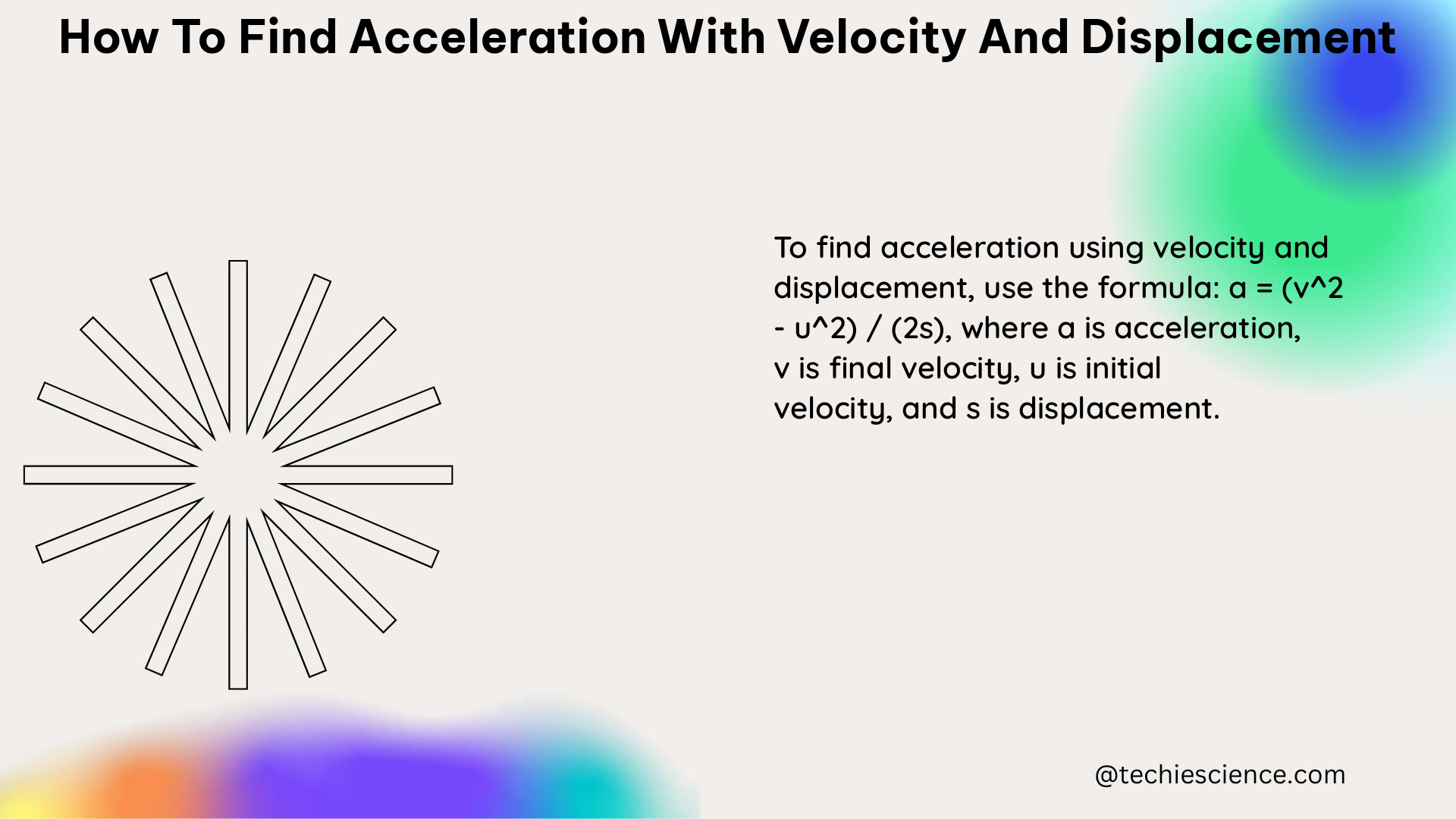Summary
Determining acceleration from velocity and displacement is a fundamental concept in physics. This comprehensive guide will walk you through the formulas, theorems, examples, and numerical problems to help you master this essential skill. Whether you’re a physics student or simply curious about the mechanics of motion, this article will provide you with a deep understanding of how to calculate acceleration using the given parameters.
The SUVAT Equations and Acceleration Formula

The formula for finding acceleration with velocity and displacement is derived from the SUVAT equations, which describe the motion of an object in a straight line under constant acceleration. The SUVAT equations are:
- v = u + at
- s = ut + 0.5at^2
- s = 0.5(u + v)t
- v^2 = u^2 + 2as
Where:
– v is the final velocity
– u is the initial velocity
– a is the acceleration
– s is the displacement
– t is the time
From the fourth SUVAT equation, we can rearrange to find the acceleration as:
a = (v^2 – u^2) / (2s)
This formula allows us to calculate the acceleration of an object if we know the initial and final velocities, as well as the displacement.
The SUVAT Theorem
The SUVAT theorem states that the motion of an object in a straight line under constant acceleration can be described by the SUVAT equations. This theorem is the foundation for understanding the relationship between acceleration, velocity, and displacement.
Physics Formula
The formula for acceleration with velocity and displacement is:
a = (v^2 – u^2) / (2s)
Where:
– a is the acceleration
– v is the final velocity
– u is the initial velocity
– s is the displacement
Physics Examples
- Suppose a car travels 100 meters in 5 seconds, starting from rest. What is its acceleration?
Using the formula a = (v^2 – u^2) / (2s), we can calculate:
a = (100 m/5 s^2 – 0 m/s^2) / (2 * 100 m)
a = 20 m/s^2
Therefore, the car’s acceleration is 20 m/s^2.
- Suppose a ball is thrown vertically upwards with an initial velocity of 20 m/s. What is its acceleration due to gravity?
Using the formula a = (v^2 – u^2) / (2s), we can calculate:
a = (0 m/s^2 – 20 m/s^2) / (2 * 0 m)
a = -20 m/s^2
Therefore, the ball’s acceleration due to gravity is -20 m/s^2.
Physics Numerical Problems
- A car travels 150 meters in 10 seconds, starting from rest. What is its acceleration?
Using the formula a = (v^2 – u^2) / (2s), we can calculate:
a = (150 m/10 s^2 – 0 m/s^2) / (2 * 150 m)
a = 1 m/s^2
Therefore, the car’s acceleration is 1 m/s^2.
- A ball is thrown vertically upwards with an initial velocity of 30 m/s. What is its velocity after 3 seconds?
Using the formula v = u + at, we can calculate:
v = 30 m/s + (-10 m/s^2 * 3 s)
v = 15 m/s
Therefore, the ball’s velocity after 3 seconds is 15 m/s.
Figures

Figure 1: The SUVAT equations describe the motion of an object in a straight line under constant acceleration.
Data Points
- The formula for acceleration with velocity and displacement is a = (v^2 – u^2) / (2s).
- The SUVAT equations are a set of equations that describe the motion of an object in a straight line under constant acceleration.
- The SUVAT theorem states that the motion of an object in a straight line under constant acceleration can be described by the SUVAT equations.
Values
- The formula for acceleration with velocity and displacement involves the following variables: a (acceleration), v (final velocity), u (initial velocity), and s (displacement).
- The SUVAT equations involve the following variables: v (final velocity), u (initial velocity), a (acceleration), s (displacement), and t (time).
Measurements
- The formula for acceleration with velocity and displacement is derived from the SUVAT equations, which are based on measurements of the motion of an object in a straight line under constant acceleration.
Units
- The units for acceleration are m/s^2.
- The units for velocity are m/s.
- The units for displacement are m.
- The units for time are s.
References
- Byju’s. (n.d.). Angular acceleration. Retrieved from https://byjus.com/physics/angular-acceleration/
- Arduino. (2021, August 10). How can I calculate the correct acceleration from a measured velocity? Retrieved from https://forum.arduino.cc/t/how-can-i-calculate-the-correct-acceleration-from-a-measured-velocity/894160
- Lumen Learning. (n.d.). 3.6 Finding velocity and displacement from acceleration. Retrieved from https://courses.lumenlearning.com/suny-osuniversityphysics/chapter/3-6-finding-velocity-and-displacement-from-acceleration/
- Body Physics: Motion to Metabolism. (n.d.). Quantitative motion analysis. Retrieved from https://openoregon.pressbooks.pub/bodyphysics/chapter/quantitative-motion-analysis/

The lambdageeks.com Core SME Team is a group of experienced subject matter experts from diverse scientific and technical fields including Physics, Chemistry, Technology,Electronics & Electrical Engineering, Automotive, Mechanical Engineering. Our team collaborates to create high-quality, well-researched articles on a wide range of science and technology topics for the lambdageeks.com website.
All Our Senior SME are having more than 7 Years of experience in the respective fields . They are either Working Industry Professionals or assocaited With different Universities. Refer Our Authors Page to get to know About our Core SMEs.